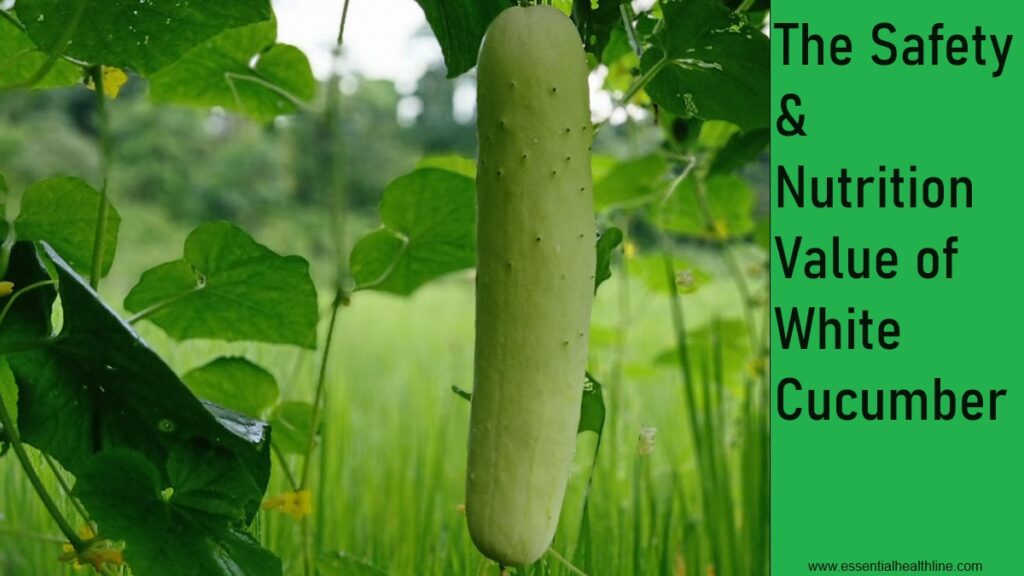It’s natural to crave something refreshing to munch on when it’s blazing hot outside. Luckily, white cucumbers come to the rescue! These fantastic, crunchy snacks are like fresh air on a scorching day. But are white cucumbers safe to eat?
Yes, white cucumbers are safe to eat! They are rich in water and nutrients. Wash them well before eating to eliminate dirt or germs. Also, buying them from trusted places can ensure they’re grown and handled safely.
This article explores whether white cucumbers are safe to eat and how they can be tasty and healthy. We’ll give you easy tips for enjoying them in your meals. Let’s find out more about these fantastic, healthy veggies!
Are White Cucumbers Safe to Eat?
White cucumbers, also called white wonder or Ann Ziata, are safe to eat and packed with essential vitamins and minerals for your health.
They may taste slightly different than green cucumbers, but they’re still delicious! Moreover, ensure they’re firm and not squishy when picking them out. Before eating, the first thing to do is to give them a good rinse to wash off dirt.
You can enjoy white cucumbers in salads, sandwiches, or snacks. But remember, it’s good to have a variety of foods in your diet, and it’s important not to overeat anything. So, go ahead and savor your white cucumbers—they’re tasty and good for you!
The Nutritional Benefits of Eating White Cucumbers
White cucumber varieties, such as Cucumis sativus, aid in hydration because their high water content makes them nutritious for maintaining proper fluid balance.
Secondly, they are also low in calories and fat, so they’re a great snack if you’re watching your weight.
They’re also full of antioxidants, which help protect cells from damage. That means they’re good for your skin and might lower your risk of getting sick.
So, grab a white cucumber next time you want a healthy snack! You can eat it in salads, sandwiches, or alone. It’s an easy way to get essential nutrients and stay healthy.
Health Benefits of Eating White Cucumber
White cucumbers offer a range of health benefits. Here are some of the benefits:
- Hydration due to high water content
- Good source of vitamin C
- Aids in digestion
- Supports weight management
- Promotes skin health
Read on.
Hydration Due to High Water Content
White cucumbers are like mini water sponges, which is great because our bodies need water to stay healthy.
Eating white cucumbers helps keep us hydrated and feeling good, supports our muscles and organs in functioning properly, and prevents nutrient deficiencies.
Good Source of Vitamin C
White cucumbers are packed with vitamin C, a superhero nutrient that boosts the immune system and promotes skin health.
Enjoying white cucumbers helps keep us strong and resilient against illness while aiding in the healing process for cuts and scrapes.
Supports Weight Management
If you’re watching your weight, white cucumbers can be your new best friend. They’re super low in calories but fulfilling because they have lots of water and fiber.
That means you can eat many white cucumbers and feel full without consuming too many calories, which can help you keep your weight in check.
Promotes Skin Health
Eating white cucumbers is like treating your skin to a big drink of water and vitamins at once. The water in white cucumbers keeps our skin hydrated and soft.
So, enjoying cucumber seeds and the whole cucumber can help us achieve healthy, glowing skin.
Does Cooking White Cucumbers Make Them Safe to Eat?
Yes, cooking white cucumbers can make them safe to eat. Sometimes, store-bought cucumbers develop white spots from fungal diseases. Cooking can effectively kill these fungi, making the cucumber safer to consume.
However, it’s vital to cook the entire cucumber thoroughly. Yet, if the white spots result from other issues like poor storage, cooking might not resolve them. Also, if the cucumber feels slimy or has an unpleasant odor, it’s best to avoid eating it.
So, while cooking can address specific problems, a closer look at the cucumber is crucial. When in doubt, it’s best to discard it. Remember, your health is the top priority!
Benefits of Eating White Cucumbers to Traditional Green Cucumbers
When considering the nutritional benefits of white cucumbers compared to traditional green ones, it’s important to note their vitamin content, water content, and overall nutrient profile.
Both cucumbers contain essential vitamins and minerals like potassium and magnesium, necessary for a healthy diet.
They are also high in water, making them a hydrating snack, especially on hot days. While there may be slight differences in taste and appearance between white and green cucumbers, their nutritional value remains similar.
Ultimately, whether you go for the old green cucumbers with the thin skin or the white cucumbers, it’s all about what you like. Both options offer valuable nutrients for overall health.
Refreshing White Cucumber Recipe
Here is a recipe for preparing white cucumbers:
- Two white cucumbers
- 1/4 cup white vinegar
- Two tablespoons of olive oil
- One tablespoon honey
- One teaspoon of Dijon mustard
- Salt and pepper to taste
- Fresh dill or parsley for garnish (optional)
Instructions:
Preparing the cucumbers involves washing them well under cold water. You can peel them, but it’s optional since their skin is soft. Then, slice them thinly using a sharp knife or a mandoline slicer.
Mix white vinegar, olive oil, honey, Dijon mustard, salt, and pepper for the dressing.
Put the sliced cucumbers in a big bowl, then pour the dressing over them and gently mix it to coat them evenly.
Cover the bowl with plastic wrap or a lid and refrigerate for 30 minutes to let the flavors mix.
Once it’s chilled, give the salad one more gentle mix. Finally, add some fresh dill or parsley before serving it as a refreshing side dish with your favorite main course.
FAQS
Mildew on White Cucumber Leaves: What to Do
Suppose you notice powdery mildew on white cucumber leaves. In that case, it’s essential to prevent further spread of this fungal disease. Here’s what you can do:
- Remove affected leaves
- Improve air circulation
- Reduce moisture
- Apply fungicide
- Monitor regularly
- Maintain plant health
Remove Affected Leaves
Start by removing leaves with powdery mildew to prevent the fungus from spreading. Potential causes include white leaves and a clear slime coating.
Improve Air Circulation
Powdery mildew likes places with not enough air moving around. Ensure your cucumber plants have space between them so air can move freely. It helps lower the high humidity and stops the fungus from growing.
Reduce Moisture
Too much water can make powdery mildew worse. Avoid watering from above, as this adds moisture to the air. Instead, use a drip irrigation system or water the soil directly to keep the leaves dry.
Apply Fungicide
If powdery mildew keeps coming back, try a special spray made to kill the fungus. Look for ones with natural repellents to stop dark spots and slimy repellents from coming back.
Monitor Regularly
Keep an eye on your cucumber plants for powdery mildew. Catching it helps you manage it better. Ensure your plants have good airflow and space. Also, consider planting Jack Frost, which naturally fights diseases like powdery mildew.
Maintain Plant Health
To keep cucumber plants healthy, provide enough sunlight, consistently water them, and avoid poor air circulation. These factors ensure proper development, strength, and mildew resistance.
Eating White Cucumbers in Raw Salads and Other Dishes
When adding white cucumbers to salads or meals, watching out for fungal diseases that can cause problems like white spots or a cottony texture on the fruits or leaves is essential. These issues usually happen when there’s too much moisture or not enough air around the plants.
To prevent these problems, ensure your cucumber plants get plenty of sunlight and are not overwatered. Properly storing them in the fridge, wrapped in paper towels or plastic wrap, can also help keep them fresh.
Most importantly, if you find cucumbers with slimy texture, it might mean they weren’t stored right or have a disease called bacterial wilt. Before using them, rinse them well to get rid of any dirt.
Additionally, if you encounter bitter cucumbers, it’s essential to understand that this can happen because of factors such as stress, inadequate inches of soil during growth, or improper storage.
Despite these challenges, white cucumbers remain a tasty and nutritious option. You can still enjoy their crispy texture and delicious flavor with proper care.
Conclusion
Are white cucumbers safe to eat? White cucumbers are safe for consumption and can enhance the flavor of your dishes. Although they appear different from green cucumbers, their light color is simply due to their type and doesn’t imply any harm.
Additionally, white cucumbers can be enjoyed in salads, sandwiches, or a healthy snack. They offer a crunchy texture and a mild flavor akin to green cucumbers.
Moreover, white cucumbers boast essential nutrients like vitamin C and have ample water content, which is beneficial for hydration. Therefore, don’t hesitate to incorporate some white cucumbers into your cooking for a fresh and delicious meal!



